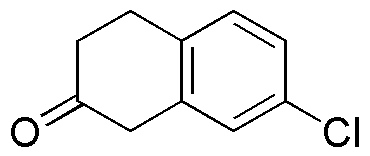7-Chloro-3,4-dihydro-1H-naphthalen-2-one is widely utilized in research focused on:
- Pharmaceutical Development: This compound serves as a key intermediate in the synthesis of various pharmaceuticals, particularly in developing anti-inflammatory and analgesic medications.
- Organic Synthesis: It is employed in organic chemistry as a building block for synthesizing more complex molecules, making it valuable for researchers in developing new compounds.
- Material Science: The compound is used in creating specialty polymers and materials, which can enhance the properties of plastics and coatings.
- Biological Research: It has been studied for its potential biological activities, including antimicrobial properties, making it a candidate for further exploration in drug discovery.
- Analytical Chemistry: This chemical can be utilized as a standard reference material in analytical methods, aiding in the calibration and validation of testing procedures.
General Information
Properties
Safety and Regulations
Applications
7-Chloro-3,4-dihydro-1H-naphthalen-2-one is widely utilized in research focused on:
- Pharmaceutical Development: This compound serves as a key intermediate in the synthesis of various pharmaceuticals, particularly in developing anti-inflammatory and analgesic medications.
- Organic Synthesis: It is employed in organic chemistry as a building block for synthesizing more complex molecules, making it valuable for researchers in developing new compounds.
- Material Science: The compound is used in creating specialty polymers and materials, which can enhance the properties of plastics and coatings.
- Biological Research: It has been studied for its potential biological activities, including antimicrobial properties, making it a candidate for further exploration in drug discovery.
- Analytical Chemistry: This chemical can be utilized as a standard reference material in analytical methods, aiding in the calibration and validation of testing procedures.
Documents
Safety Data Sheets (SDS)
The SDS provides comprehensive safety information on handling, storage, and disposal of the product.
Product Specification (PS)
The PS provides a comprehensive breakdown of the product’s properties, including chemical composition, physical state, purity, and storage requirements. It also details acceptable quality ranges and the product's intended applications.
Certificates of Analysis (COA)
Search for Certificates of Analysis (COA) by entering the products Lot Number. Lot and Batch Numbers can be found on a product’s label following the words ‘Lot’ or ‘Batch’.
*Catalog Number
*Lot Number
Certificates Of Origin (COO)
This COO confirms the country where the product was manufactured, and also details the materials and components used in it and whether it is derived from natural, synthetic, or other specific sources. This certificate may be required for customs, trade, and regulatory compliance.
*Catalog Number
*Lot Number
Safety Data Sheets (SDS)
The SDS provides comprehensive safety information on handling, storage, and disposal of the product.
DownloadProduct Specification (PS)
The PS provides a comprehensive breakdown of the product’s properties, including chemical composition, physical state, purity, and storage requirements. It also details acceptable quality ranges and the product's intended applications.
DownloadCertificates of Analysis (COA)
Search for Certificates of Analysis (COA) by entering the products Lot Number. Lot and Batch Numbers can be found on a product’s label following the words ‘Lot’ or ‘Batch’.
*Catalog Number
*Lot Number
Certificates Of Origin (COO)
This COO confirms the country where the product was manufactured, and also details the materials and components used in it and whether it is derived from natural, synthetic, or other specific sources. This certificate may be required for customs, trade, and regulatory compliance.

